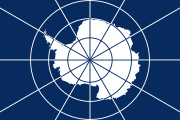
Back Antarktiese Verdrag Afrikaans نظام معاهدة القارة القطبية الجنوبية Arabic معاهدة القطب الجنوبى ARZ Tratáu Antárticu AST Antarktika haqqında konvensiya Azerbaijani Дагавор аб Антарктыцы Byelorussian Антарктически договор Bulgarian অ্যান্টার্কটিক চুক্তি ব্যবস্থা Bengali/Bangla Tractat Antàrtic Catalan Antarktický smluvní systém Czech
| The Antarctic Treaty French: Traité sur l'Antarctique Russian: Договор об Антарктике Spanish: Tratado Antártico | |
|---|---|
 | |
| Type | Condominium |
| Signed | 1 December 1959[1] |
| Location | Washington, D.C., United States |
| Effective | 23 June 1961 |
| Condition | Ratification of all 12 signatories |
| Signatories | 12[2] |
| Parties | 57[2] |
| Depositary | Federal government of the United States[2] |
| Languages | English, French, Russian, and Spanish |
| Full text | |

The Antarctic Treaty and related agreements, collectively known as the Antarctic Treaty System (ATS), regulate international relations with respect to Antarctica, Earth's only continent without a native human population. It was the first arms control agreement established during the Cold War, designating the continent as a scientific preserve, establishing freedom of scientific investigation, and banning military activity; for the purposes of the treaty system, Antarctica is defined as all the land and ice shelves south of 60°S latitude. Since September 2004, the Antarctic Treaty Secretariat, which implements the treaty system, is headquartered in Buenos Aires, Argentina.[3]
| International ownership treaties |
|---|
The main treaty was opened for signature on 1 December 1959, and officially entered into force on 23 June 1961.[4] The original signatories were the 12 countries active in Antarctica during the International Geophysical Year (IGY) of 1957–58: Argentina, Australia, Belgium, Chile, France, Japan, New Zealand, Norway, South Africa, the Soviet Union, the United Kingdom, and the United States.[1] These countries had established over 55 Antarctic research stations for the IGY, and the subsequent promulgation of the treaty was seen as a diplomatic expression of the operational and scientific cooperation that had been achieved. As of 2024[update], the treaty has 57 parties.[5]
- ^ a b "Antarctic Treaty" in The New Encyclopædia Britannica. Chicago: Encyclopædia Britannica Inc., 15th edn., 1992, Vol. 1, p. 439.
- ^ a b c Cite error: The named reference
depositarywas invoked but never defined (see the help page). - ^ "ATS – Secretariat of the Antarctic Treaty". ats.aq. Archived from the original on 15 May 2019. Retrieved 10 February 2010.
- ^ "Antarctic Treaty". United Nations Office for Disarmament Affairs. United Nations. Retrieved 28 March 2018.
- ^ "Antarctic Treaty". United States Department of State. 22 April 2019. Retrieved 11 September 2022.